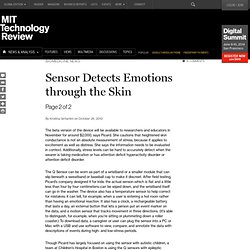

Medical and Health Related Projects with Arduino. Amici Community. Textile sensors to measure sweat pH and sweat-rate during exercise - DORAS - DCU. PowerPoint-Präsentation. BAM Labs Introduces New Touch-Free Life Care (TLC) System for Senior Living Communities. Revolutionary TLC System Turns Any Bed Into a Smart Bed That Helps Seniors Live Healthier and Independently WASHINGTON, DC--(Marketwire - Oct 17, 2011) - LeadingAge - BAM Labs, the innovator in touch-free connected care, announced today the Touch-free Life Care™ System that puts smart bed technology within reach of every care facility.

By transforming any conventional bed into a smart bed, BAM Labs' TLC System™ empowers caregivers to remotely monitor residents based on their health management needs -- without attaching anything to the person's body. The revolutionary TLC System is being demonstrated at the 2011 LeadingAge annual meeting and IAHSA global aging conference in BAM Labs' booth #1430 and in the Idea House. The TLC sensor mat is placed under any bed mattress and continuously transmits the person's "bio-signal" to the TLC analysis cloud.
The TLC System analyzes this data to track heart rate, breathing rate, motion and presence. NovaSensor medical pressure sensor – NPC-100. 1.

Definitions Unless otherwise agreed to by Licensor, the following terms shall mean: “Documentation” means all material, including all printed material and on-line or electronic documentation (excluding training materials), referencing the Software and Third-Party Software provided hereunder. “Software” means Licensor’s proprietary computer software and software security devices provided by Licensor under this License. “Third-Party Software” means any proprietary computer software owned by a third party that Licensor may provide to you hereunder. 2. 2.1 Subject to the terms of this License, Licensor hereby grants to you a non-transferrable and nonexclusive license to use the Software and Documentation, including upgraded, modified or enhanced versions provided by Licensor and to use the Third-Party Software, all for your internal business purposes only 2.3 Certain software Licensor provides to you may contain Third-Party Software, including but not limited to “open source” software. 3.
Glove Pressure Mapping System. The Glove Pressure Mapping System (GPMS) is a multi-sensor hand force data acquisition system that consists of an Ultrathin Glove Mat and a Computer Interface.

The GPMS incorporates the ISS sensors in 20 and 24 sensor configurations. The sensor locations can easily be modified by the customer and are mounted using double-sided tapes. The individual sensors are covered with a Teflon coated laminate which makes them more durable. The GPMS has various ergonomics applications including hand-tool analysis, design and research, as well as clinical applications. Twenty and twenty-four sensors are used in the standard configurations that results in a sampling rate of over 100 Hz. Sample Results Glove Configurations Gloves are designed to fit both left and right hands (ambidextrous) and can be ordered in various sizes as shown below: How to Measure for Proper SizingTake a measuring tape and wrap around the hand over the knuckles. Specifications Additional Hardware: Sensor Detects Emotions through the Skin. The beta version of the device will be available to researchers and educators in November for around $2,000, says Picard.

She cautions that heightened skin conductance is not an absolute measurement of stress, because it applies to excitement as well as distress. She says the information needs to be evaluated in context. Additionally, stress levels can be hard to accurately detect when the wearer is taking medication or has attention deficit hyperactivity disorder or attention deficit disorder.
The Q Sensor can be worn as part of a wristband or a smaller module that can slip beneath a sweatband or baseball cap to make it discreet. After field testing, Picard’s company designed it for kids: the actual sensor–which is flat and a little less than four by four centimeters–can be wiped down, and the wristband itself can go in the washer. “The beauty of this is, it’s a way of providing feedback and intervention that is much less socially intense,” Werner says.